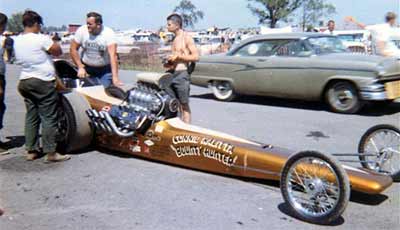|


(Jim Gardner Photo)
The Nationals was an entire week of activities,
climaxing with final eliminations on Monday.
The action began on Monday, Tuesday and Wednesday,
in NHRA’s official Tech Inspection
area. Before the IRP circle track was built,
tech was held in the parking lot of the shopping
center at the corner of 16th street, just
east of what is now I-465.
Racers placed their cars in one of the lines
that curled around the outer edge of the parking
lot. One was for “Hot Car Tech,” another
reserved for “Stock Car Tech,” and
both were heavily populated. A third was the “Reject
Line” for those cars that had failed
to pass tech inspection, been repaired and
were back for another shot at earning their
Nationals contestant number.
George Hurst, founder of the Hurst Shifter
firm, saw a terrific promotional opportunity
and created the “Hurst Aid” trucks
that provided welding, cutting, grinding, fabricating
and practically any service needed to get a
race car through the tech lines. It was the “under
card” for the main event, a chance to
see up-close every race car that would run
at IRP, listen to the NHRA inspectors as they
delivered “Go or No-Go” verdicts,
and see the hero drivers and mechanics of the
day. Tech Inspection at the shopping center
was an experience in itself.
IFor many years the Nationals field included
more than 1,000 race cars being rolled through
these lines. Racers and their families passed
the time by shopping at the stores in the center.
A cafeteria offered great Indiana farm food
at reasonable prices for hungry people. Of
course there was a drug store, where that drag
racing staple of nourishment, beer and other
stronger refreshments were sold in quantities
befitting an event of the size and stature
as The Nationals.
At night the Indiana State Fair was open at
the State Fairgrounds, and racers and fans
alike enjoyed that thick slice of Americana.
Some years there was circle track racing action
at the Fair, with USAC Champ cars and even
flat-track motorcycles running on the one-mile,
dirt horse track! IRP itself was a carnival
of sights, sounds and colors. Wooden slatted
snow fencing marked the roads and staging lanes.
The D-A tower stood watch over the starting
line and track, and spectators jockeyed into
early seats on the bleachers that lined only
a small part of the east side of the track.
A rolling, grassy knoll later provided seating
more appropriate for a summer concert than
ground-shaking, ear splitting drag racing competition.
Down the west side of the track grandstands
extended to about half-way. From there spectators
parked their cars and watched from atop hoods,
just like it was in the days of the original
NHRA Safety Safari.
The “Hot Car” pits were once located
in the west-side pits and the Stockers were
pitted across the way, on the east side. Dragsters
used push-starts and had to negotiate a sharp
left turn as the push cars were accelerating
them. Since “diggers” were designed
to go straight, that untimely left turn claimed
a couple of cars each year. There were even
a few potentially disastrous incidents where
push-started dragsters crashed through the
snow fences and into the bottom seats of the
bleachers. Luckily there were no serious injuries
to drivers or spectators, but the situation
did produce several anxious moments.
In 1964 NHRA invited the nitro burning fuel
dragsters to Indy. Prior to ‘64, the
Nationals had run for several years as a “gasoline
only” event. Nitro was deemed too dangerous
and too expensive, so NHRA banned it until
that magic year.
During the 1964 season Tampa’s Don Garlits
had been taking the country by storm. His Swamp
Rat VI, now called the “Wynns Jammer,” began
using the new Goodyear “smooth sidewall” drag
slicks, and most drag racing pundits thought
the tires were what caused Garlits’ sudden
dominance.
Other observers noted that Garlits had also
switched from a Hilborn four-hole injector
to an Enderle “Bird Catcher,” and
had added a curious new exhaust header design
called “zoomies.” These were shorter
and angled differently than conventional “weedburner.” Garlits’ “zoomie” pipes
came back and directed the exhaust blast right
at the tires. Typically, Garlits wasn’t
talking, but others claimed the zoomie pipes
blew away sand and pebbles while heating the
rubber and providing downward thrust, all of
which created better bite for the spinning,
smoking tires. Any aid to traction was welcome,
as everyone used lock-up clutches and spun
the tires right off the starting line. It would
be three more years before the “slipper
clutch” technology swept drag racing
and forever eliminated the fuelers’ trademark
clouds of quarter-mile long, white tire smoke.

|